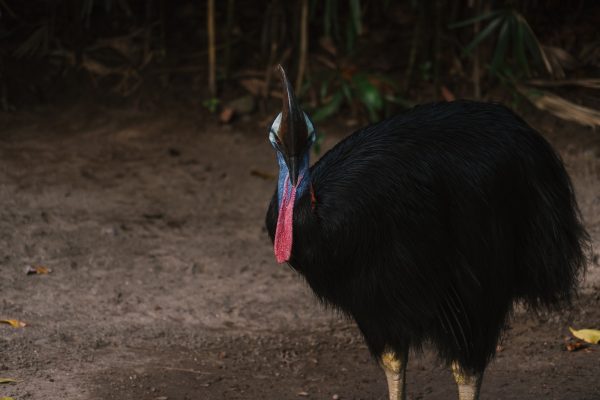Introduction
The Cassowary is a species of flightless bird native to the rainforests of New Guinea and northeastern Australia. It’s known for its distinctive, helmet-like casque and colorful neck and head.
Scientific Classification
- Kingdom: Animalia
- Phylum: Chordata
- Class: Aves
- Order: Casuariiformes
- Family: Casuariidae
- Genus: Casuarius
- Species: The three species of cassowaries are C. casuarius (Southern Cassowary or Double-wattled Cassowary), C. unappendiculatus (Northern Cassowary or Single-wattled Cassowary), and C. bennetti (Dwarf Cassowary).
Physical Traits
Size and Weight
Adult cassowaries stand up to 5-6 feet tall and can weigh between 30 to 70 kilograms. Females are typically larger and more dominant than males.
Distinctive Features
They are known for their large size, colorful head and neck (blue and red), bristly black feathers on their body, and a horn-like casque on their head. They have powerful legs with sharp, dagger-like claws on their three-toed feet.
Life Span
Cassowaries can live up to 40-50 years in the wild, though this may extend in captivity.
Habitat
Cassowaries are native to the tropical rainforests of New Guinea and northeastern Australia. They are well-adapted to these environments and can also be found in mangroves and grasslands.
Diet
Omnivorous Feeding
Cassowaries are omnivores, but their diet primarily consists of fruit. They also eat small invertebrates, fungi, and occasionally small mammals and reptiles.
Reproduction
Breeding and Nesting
Cassowaries mate during the dry season. The female lays three to eight large, green eggs in a prepared nest on the ground. The male incubates the eggs for about 50 days and takes care of the chicks alone once they hatch.
Conservation Status
Threatened Species
The IUCN Red List classifies the Southern Cassowary as Vulnerable and the Dwarf Cassowary as Near Threatened. The primary threats to these birds are habitat loss due to deforestation, vehicle strikes, and dog attacks.
Interesting Facts
Seed Dispersal
Cassowaries play a critical role in rainforest health by consuming and dispersing seeds in their droppings.
Defensive Power
While usually shy, cassowaries can become aggressive if threatened and are capable of inflicting serious injuries with their powerful legs and sharp claws.
Swimming Ability
Despite their bulk, cassowaries are excellent swimmers, capable of crossing wide rivers and swimming in the sea.
Casque Mysteries
The function of the cassowary’s casque is still not fully understood, though theories suggest it may be used for protection, to push through the underbrush, as a weapon in dominance disputes, or for acoustic purposes.


